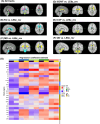Plasma proteomic biomarkers as mediators or moderators for the association between poor cardiovascular health and white matter microstructural integrity: The UK Biobank study
- PMID: 39822062
- PMCID: PMC11864230
- DOI: 10.1002/alz.14507
Plasma proteomic biomarkers as mediators or moderators for the association between poor cardiovascular health and white matter microstructural integrity: The UK Biobank study
Abstract
Introduction: The plasma proteome's mediating or moderating roles in the association between poor cardiovascular health (CVH) and brain white matter (WM) microstructural integrity are largely unknown.
Methods: Data from 3953 UK Biobank participants were used (40-70 years, 2006-2010), with a neuroimaging visit between 2014 and 2021. Poor CVH was determined using Life's Essential 8 (LE8) and reversing standardized z-scores (LE8z _rev). The plasma proteome was examined as a potential mediator or moderator of LE8z _rev's effects on quantitative diffusion-weighted magnetic resonance imaging (dMRI) metrics.
Results: LE8z_rev was significantly associated with deteriorated WM microstructural integrity, as reflected by lower tract-averaged fractional anisotropy (dMRI-FAmean), (β ± standared error (SE): -0.00152 ± 0.0003, p < 0.001) and higher tract-averaged orientation dispersion (dMRI-ODmean), (β ± SE:+0.00081 ± 0.00017, p < 0.001). Ten strongly mediating plasma proteins of 1463 were identified, with leptin as the principal driver.
Discussion: Poor CVH is linked to poor WM microstructural integrity measures (lower FAmean and higher ODmean), mostly mediated through leptin.
Highlights: Up to 3953 UK Biobank participants were selected for this study. Poor cardiovascular health (CVH) was determined using Life's Essential 8. The plasma proteome was examined as a potential mediator or moderator of poor CVH's effect on dMRI metrics. Ten plasma proteins were identified with strong mediating effects, with leptin being the principal driver.
Keywords: Life's Essential 8; aging; cardiovascular health; diffusion‐weighted magnetic resonance imaging; plasma proteomic biomarkers; white matter microstructural integrity.
© 2025 The Author(s). Alzheimer's & Dementia published by Wiley Periodicals LLC on behalf of Alzheimer's Association.
Conflict of interest statement
The authors declare no conflicts of interest. Author disclosures are available in the Supporting Information.
Figures




Similar articles
-
Plasma proteomic biomarkers and the association between poor cardiovascular health and incident dementia: The UK Biobank study.Brain Behav Immun. 2024 Jul;119:995-1007. doi: 10.1016/j.bbi.2024.05.005. Epub 2024 May 6. Brain Behav Immun. 2024. PMID: 38710337 Free PMC article.
-
Mediating and moderating effects of plasma proteomic biomarkers on the association between poor oral health problems and brain white matter microstructural integrity: the UK Biobank study.Mol Psychiatry. 2025 Feb;30(2):388-401. doi: 10.1038/s41380-024-02678-3. Epub 2024 Jul 30. Mol Psychiatry. 2025. PMID: 39080466 Free PMC article.
-
Cardiovascular health, infection burden and their interactive association with brain volumetric and white matter integrity outcomes in the UK Biobank.Brain Behav Immun. 2023 Oct;113:91-103. doi: 10.1016/j.bbi.2023.06.028. Epub 2023 Jun 29. Brain Behav Immun. 2023. PMID: 37393057 Free PMC article.
-
Associations of Life's Simple 7 with cerebral white matter hyperintensities and microstructural integrity: UK Biobank cohort study.Eur J Neurol. 2023 May;30(5):1200-1208. doi: 10.1111/ene.15750. Epub 2023 Mar 2. Eur J Neurol. 2023. PMID: 36794682
-
Evidence for Altered White Matter Organization After Mild Traumatic Brain Injury: A Scoping Review on the Use of Diffusion Magnetic Resonance Imaging and Blood-Based Biomarkers to Investigate Acute Pathology and Relationship to Persistent Post-Concussion Symptoms.J Neurotrauma. 2025 Apr;42(7-8):640-667. doi: 10.1089/neu.2024.0039. Epub 2024 Aug 21. J Neurotrauma. 2025. PMID: 39096132
References
-
- Guerchet M, Prince M, Prina M. Numbers of people with dementia worldwide: An update to the estimates in the World Alzheimer Report 2015. Alzheimer's Disease International; 2020.
-
- Alzheimer's Association . 2023 Alzheimer's disease facts and figures. Alzheimers Dement. 2023;19(4):1598‐1695. - PubMed
-
- Sosa‐Ortiz AL, Acosta‐Castillo I, Prince MJ. Epidemiology of dementias and Alzheimer's disease. Arch Med Res. 2012;43:600‐608. - PubMed
-
- Lindeboom J, Weinstein H. Neuropsychology of cognitive ageing, minimal cognitive impairment, Alzheimer's disease, and vascular cognitive impairment. Eur J Pharmacol. 2004;490:83‐86. - PubMed
MeSH terms
Substances
Grants and funding
LinkOut - more resources
Full Text Sources

